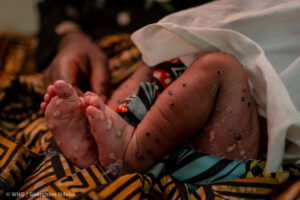
©FAO/Yousef Alrozzi
Hakmah El-Hamidi, a resident of Al-Zuwayidah in the central Gaza Strip, has been raising livestock for livelihood since she was a child, waking up at 7 a.m. to feed and care for them, repeating this task in the afternoon and evening.
Amid the ongoing horror of the conflict and alongside the tens of thousands of human victims in Gaza, she has lost at least half of her animals.
“There is no food, no barley, no fodder and also no water during the conflict; we had over forty heads of livestock, and now they’re twenty or even less,” says Hakmah.
These losses have dealt a heavy blow to her family’s livelihood. Nonetheless, Hakmah says, “The Food and Agriculture Organization of the United Nations (FAO) has helped us a lot when they provided us with fodder. Thank God, our animals have gotten healthier and stopped dying.” She says the veterinary kit provided by FAO also “helped me a lot; it has vitamins and anti-flea spray. The animals were getting bitten by fleas so I spray it, as you can see. It’s really good.”
Despite the challenges of security and access faced by all the humanitarian agencies bringing aid to Gaza, FAO has distributed fodder to over 4,400 livestock-keeping families in Deir al-Balah, Khan Younis and Rafah governorates of Gaza. Veterinary kits were additionally given to about 2,400 families to improve animal health and preserve livelihoods across the Strip. The kits include much-needed inputs to safeguard animals’ health, such as multivitamins, disinfectants, salt blocks and iodine wound sprays.
Of course, the support Hakmah has received is far from enough. She says she still needs more fodder, more medicines and roofing material to protect her animals.
The ongoing hostilities have caused the collapse of local food production and contributed to the rapid deterioration of food security in Gaza. Some 86 per cent of the population or 1.84 million people in Gaza are facing high levels of acute food insecurity with the risk of famine persisting across the whole Gaza Strip.
According to satellite data in a recent assessment carried out by FAO and the United Nations Satellite Centre, over two-thirds of cropland has been destroyed.
FAO’s rapid assessments also indicate that almost 150,00 or 95 per cent of Gaza’s cattle have died, and nearly all calves have been slaughtered. Fewer than 25,000 sheep (around 43 per cent) and only about 3,000 goats (around 37 per cent) remain alive. Dramatic losses are also reported in the poultry sector, with only 34,000 (or 1 per cent) of the birds left living.

Ward Saeed, originally from El-Zetoun in Gaza’s old city and now displaced in Deir al-Balah, is another livestock keeper who has suffered overwhelming losses of her animals in the course of a traumatic year.
“We were displaced and moved south because of the war. We took our animals with us and lost half of them— most of them— along the way. These are the only animals left, and they are our only livelihood source,” she says. But for her and her family, trying to find food for the livestock means risking their lives amid falling missiles.
Also read: Gaza gets animal fodder for the first time during the conflict
Ward also says, “We benefited from FAO’s support, the fodder and the veterinary kit, but this is not enough, we need more.”
She says the most important needs are livestock fodder, shelter and food. And fodder is next to impossible to find amid the enormous numbers of displaced people who are all desperately trying to feed themselves and their animals.
Given that agricultural aid is one of the key components of humanitarian assistance, helping farmers strengthen their resilience and feed their communities and families, it comes as little surprise that fodder was the most important pre-war import in Gaza. Almost 650 trucks were entering the Strip with fodder every month, before 7 October.
FAO, supported by the Governments of Belgium, Italy, Malta and Norway, said it is working closely with the Palestinian Ministry of Agriculture and local non-governmental organizations to distribute the fodder and veterinary kits to Gaza’s livestock keepers.
The operation has faced logistical and security-related obstacles, particularly the restrictions at crossings and the collapse of law in Gaza, which constrains the delivery of aid.
But FAO is ready to scale up efforts to deliver more inputs to Gazan farmers and herders, once access and security conditions are fully restored. New deliveries will include feed concentrate, greenhouse plastic sheets, plastic water tanks, vaccines, energy blocks, plastic sheds, animal shelters and more veterinary kits.
For Gaza’s livestock keepers, like Hakmah and Ward, this support from FAO and its partners to help sustain their battered livelihoods can’t come soon enough.
Source: The FAO News And Media Office, Rome.
– global bihari bureau





